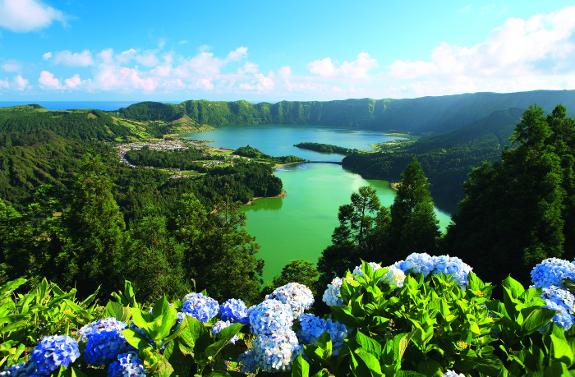

Sections
Highlight

J. GARCÍA BLANCO
Friday, 28 June 2019, 11:56
Compartir
At first glance it is a simple building, three storeys high and a blue and white front, situated beside the port on a small island surrounded by the immensity of the Atlantic. Despite its apparent insignificance, Café Sport de Horta - or Peter's Café - on the island of Faial in the Azores, has given shelter to sailors from the five continents and has become a legend. It opened in 1918 and since then has been frequented by merchant seamen, sailors from the Royal Navy and US Navy, yacht captains, courageous whalers and even spies. Today it is one of the archipelago's tourist landmarks and the atmosphere inside transports you to a thousand adventures on the high seas. Without a doubt, if Moby Dick had been written in the 20th century, Captain Ahab would have gone to Peter's to look for harpooners to pursue the feared object of his obsession.
How to get there. TAP flies to Terceira and São Miguel with a stop in Lisbon or Porto. There are internal flights and ferries between the islands.
Where to stay. In Terceira, the Hotel Angra Marina has unbeatable views of the Atlantic.
Where to eat. Restaurant Ti Choa in Terceira, has friendly service and typical dishes.
Further information. Azores Tourism (www.visitazores.com/en).
That same spirit of adventure, far from dispelling with modernity, can still be perceived on the nine islands of the Azores. Their volcanic origin and delightful and exuberant natural setting contributes to that and the beauty is difficult to describe. It is not surprising that the New York Times has named the Azores as one of the essential destinations to visit in 2019.
The physionomy of the archipelago was shaped by lava and ashes, leaving spectacular enclaves for geotourism. On Faial, for example, is Capelinhos, a volcano which last erupted in 1957, creating several square kilometres of solid ground and partly burying an iconic lighthouse, beneath which there is now a very interesting information centre. There are impressive 'caldeiras' (craters) on all the islands, although the one called Sete Cidades on the island of São Miguel is particularly spectacular. Its interior contains a picturesque hamlet and two lagoons, one green and one blue, the most photogenic in the Azores. On the other side is the Funas Valley, another crater covered with leafy vegetation. There you can try a traditional dish, 'cozido das Furnas', which is prepared by burying the saucepans for several hours to take advantage of the volcanic heat.
The intricate geology of the Azores also enables you to enter the entrails of the Earth, like characters in a novel by Verne. The Algar do Carvão, on the island of Terceira, is a volcanic chimney 90 metres deep which can easily be visited by steps leading into the interior. It is full of stalagtites and stalagmites and there is an underground lake. Other telluric enclaves are the Furna do Enxofre -one of the biggest volcanic caves in the world, on Graciosa - and the Gruta das Torres, a lava tube five kilometres in length on the island of Pico.
But the Azores are not all volcanoes and caves. There are more relaxing options too, such as the lovely beaches, most of them of volcanic sand - the Mosteiros beach on São Miguel, the biggest and most touristy island, is outstanding - but there are also white sand beaches such as Praia Formosa on Santa Maria.
It is also possible to swim in more exotic places such as thermal waters in natural pools created by the lava, for example the Termas do Carapacho on Graciosa, or the warm waterfalls of Caldeira Velha on São Miguel.
If you're looking for peace and quiet, it's best to take refuge on the smallest island of Corvo. With just 425 inhabitants, this diminutive enclave which used to be a refuge for pirates is now a paradise of tranquility. With its rugged cliffs and picturesque hamlets of black and white houses, it is the perfect place to disappear to.
Lovers of active tourism will also find plenty on offer. There are horseback excursions to see the volcanic 'caldeiras', mountain bike routes, diving trips with blue sharks and boat trips to watch sperm whales and other cetaceans. In fact, the whaling past of the islands has resulted in other tourist attractions. Until just over 30 years ago, many local people used to hunt 'baleas'. That past is still a recent memory and has been preserved in museums about the 'Whale Factories' on Faial, Pico and São Jorge, and the Scrimshaw Museum in the Café Sport, with authentic works of art made with the teeth of sperm whales. It is a legacy of which, without a doubt, Captain Ahab would have been proud.
Publicidad
Publicidad
Publicidad
Publicidad
Reporta un error en esta noticia
Necesitas ser suscriptor para poder votar.